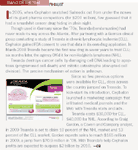Brand of the Year: Crestor
Pharmaceutical Executive
For aiming to be a game-changer in cardiovascular disease, we recognize comeback kid Crestor as the year's No. 1. Plus three fine finalists.
Though 2008 was not a banner year for pharma, the industry can still pat itself on the back: It continued to extend control over HIV with three important new drugs, including Merck's Isentress; Treanda, brought to market by Cephalon, became the first advance against CLL in seven years; and Pfizer revamped an old pain drug as Lyrica for a newish condition, fibromyalgia. All three drugs showcased pharma's drive toward innovation in discovery, development, or marketing. For patients who benefited by them, each drug was no doubt the brand of the year. (See sidebars for more on each of these three finalists.)
For our third annual Brand of the Year, however, Pharm Exec is honoring AstraZeneca's Crestor (rosuvastatin)—a selection that struck some of our advisors as eccentric. After all, Crestor is not a medical breakthrough, first in class, or even new. Cynics asked if its recent success is anything more than a marketing marvel.

The Crestor brand team, led by Lisa Nanfra, may be doing for C-Reactive Protein what they did for atherosclerosis. "It will be up to the regulatory and other guidelines bodies to make use of the JUPITER trial information in terms of clinical practice," Nanfra says. "But regardless, we are incredibly proud of the fact that we have been part of helping advance scientific knowledge."
Crestor's sales are a marvel—and something of a mystery. Since generic simvastatin (Zocor) hit in 2006, it has wreaked havoc on the $34 billion cholesterol market, long a leading engine of the blockbuster economy. Copycats immediately crushed sales of Zocor with a 97 percent switch rate in the first 12 months, according to Datamonitor. Sales of Pfizer's Lipitor—the fattest pharma cash cow ever—plunged 20 percent from Q1 2005 to Q2 quarter 2008. Crestor, alone among branded statins, has made gains—big ones. According to the drugmaker, in 2005, the superstatin recorded $1.2 billion in global sales; in 2006, $2.1 billion; in 2007, $2.8 billion; and in 2008, an estimated $3.5 billion.
Crestor's improbable success derives from AZ's determined belief in the drug's value and its willingness to take big risks to demonstrate that value. Born amid a tempest, Crestor weathered the worst of the post-Vioxx storms to find safe harbor as the statin of choice for patients at highest risk for cardiovascular disease; in order to make the most of its major feature, high potency, AstraZeneca invested in an ambitious range of postmarketing trials. In 2007, the science earned Crestor the only indication among its class to treat atherosclerosis.

A print ad (left) and three images from a TV spot for Crestors atherosclerosis DTC campaign.
A giant Crestor trial called JUPITER was also responsible for what was arguably 2008's biggest medical news, supporting the use of statins to prevent heart attack and stroke in healthy people with normal LDL cholesterol but high levels of a C-Reactive Protein (CRP), a marker for inflammation. "The trial was originally conceived to see how important a factor inflammation is in cardiovascular disease," CEO David Brennan told The Wall Street Journal last March.
If, as expected, FDA approves Crestor to lower CRP, it will be "another plank in the bridge we have built for this product," Brennan said. It will also likely set in motion a paradigm shift in cardiovascular medicine, addressing the long-unmet medical need of the healthy—who suffer nearly half of all heart attacks and strokes.

Expanding the statin market to include testing and treatment for inflammation could send Crestor sales as high as $15 billion by 2016, when the patent expires. Such a scenario is unlikely to materialize unless AZ can win the daunting cost-effectiveness battle, but one thing is certain: As the other statins fade, Crestor's best days are still ahead.
Born Under a Cloud
According to 2004 American Heart Association (AHA) estimates, cardiovascular disease afflicts 78 million Americans (half 65 or over), and is responsible for 58 percent of all deaths. With those numbers, statins were predictably hailed as wonder drugs by doctors and a license to print money by Wall Street. Public-health officials even joked about putting statins in the water, like fluoride.

The first statins quickly revealed two key side effects in a small percentage of patients: kidney problems and muscle damage. Although the class has proved to be well tolerated by many millions of patients, in 2001 Bayer's statin, Baycol, was yanked from the market following 31 deaths. Sales dropped for the four other statins on the market.
Such was the climate when rosuvastatin came before FDA with data showing it lowered LDL cholesterol and raised HDL further and faster than its rivals. But higher potency often meant higher toxicity, and the agency demanded more safety tests. Approval was finally granted in July 2003.
With its top-selling drug, Prilosec, losing its $6 billion annual sales to generics, AZ craved a seat on the statin gravy train. But just as the statin marketing battle was heating up, the Vioxx scandal broke, fomenting near panic about drug safety. The cloud over Crestor took on a toxic hue.

Yet the safety albatross that stymied Crestor's early growth was not simply a matter of bad timing, says Stan Bernard, MD, MBA, of Bernard Associates. "Pfizer recognized that Crestor's superior potency was a threat to Lipitor, so the company—skillfully and stealthily—refocused the statin discussion from efficacy to toxicity," he recalls. Even before Crestor was launched, it had been positioned as a niche product too dangerous for ordinary use.
The British medical journal The Lancet slammed AZ for running its marketing machine "too hard and too fast" given the safety issues, and Sidney Wolfe, MD, of the consumer group Public Citizen petitioned FDA to withdraw Crestor from the market. Then, at a now-legendary appearance before a Senate hearing on Vioxx and drug safety, FDA researcher David Graham included Crestor on a list of five drugs he wanted off the market. With sales plummeting, AstraZeneca ran full-page newspaper ads, defending Crestor, and TV spots claiming it showed superiority over other statins, but the bad press persisted when FDA slammed the ads as misleading. Crestor sales were $908 million in 2004, compared to market leader Lipitor's $10 billion and Zocor's $4 billion.
The cloud began to lift only when the results of one of the largest ever post-marketing studies of statins showed that all four marketed statins were safe. Its reputation tattered but intact, Crestor took its place as statin of choice for patients at highest risk of heart disease. As the most powerful statin arriving late to the party, Crestor presented a challenge: How to strengthen its claim to superiority so it could withstand the class effect when Merck's Zocor went generic in 2006.
A GALAXY of Trials
The skies over Crestor brightened for good in March 2006 with publication of the results of AstraZeneca's ASTEROID trial in the Journal of the American Medical Association. The data showed for the first time that a statin could reverse the progression of atherosclerosis (inflamed arteries due to the accumulation of macrophages caused by plaque buildup), the leading cause of heart attack and stroke, and a condition afflicting an estimated 4.5 million Americans. Crestor also reduced LDL by 53 percent and upped HDL by 15 percent—the best performance by any statin.
ASTEROID was led by Steven Nissen, MD, a star cardiologist at the Cleveland Clinic and frequent critic of drug safety. "The results were shockingly positive," he told The New York Times. But because the study did not measure outcomes, naysayers were quick to point out that Crestor's feat of reducing arterial fat deposits by 7 to 9 percent may not decrease cardio events. Nissen disagreed. "You get rid of the lipid, and what's now left is the fibrous material, which won't rupture," he said. "It's a stable scar—there is nothing to cause morbidity or mortality."
AZ followed up with METEOR, basically ASTEROID with a bigger, healthier population. METEOR enrolled close to 1,000 people with only one risk factor for heart disease, but who were showing early-stage athero. Asymptomatic, these people would go untreated; for some, the first sign of disease would be a heart attack or stroke.
Using ultrasound, METEOR showed that there was essentially no increase in artery-wall thickness in the Crestor group, while in the placebo group atherosclerosis continued unchecked. It offered one remarkable take-away: Though Crestor failed to reduce plaque, it put the brakes on further buildup. Equally important, LDL dropped 49 percent, while HDL rose 8 percent compared to placebo.
As their names suggest, ASTEROID, METEOR, and JUPITER were related, part of the GALAXY program conceived when the molecule was in its preclinical stage. "We thought hard about how we could fulfill the promise that a high level of potency could deliver," says Alex Gold, MD, Crestor development brand leader. "So we began developing a program of trials—some with surrogate endpoints, others that were outcomes trials, to test Crestor against the entire range of cardiovascular problems."
With its plaque-slowing indication, AstraZeneca began moving the needle beyond highest risk patients. But as a real game-changer, Crestor's cholesterol-lowering prowess was not sufficient. Nothing extends a brand like finding a new disease to treat—but finding a new group of untreated patients at risk for the same old disease works just as well.
"Building" the Brand
In November 2007, FDA approved AZ's application for a second indication for Crestor, to treat atherosclerosis, based mainly on ASTEROID and METEOR data. AstraZeneca lost no time in promoting Crestor as the only statin proven to slow progression of the disease.
In an effort to spur a grassroots educational campaign to raise awareness of atherosclerosis, AZ launched a campaign, "Us Against Athero," whose Web site (usagainstathero.com) offers the latest in interactivity. Its most fetching feature is the animated "Artery Explorer" movie, a Fantastic Voyage-like visualization of athero doing its dirty work. The Artery Explorer is also the name of the trailer, equipped with an eight-person motion simulator, that travels nationwide to offer communities a visceral lesson in the dangers of athero. The Web site also includes a three-part film about risk, prevention, treatment, and advocacy, and "Athero News," a Cardio 101 from the Mayo Clinic.
"There wasn't anything else out there to help people understand atherosclerosis—what cholesterol had to do with it, and what it has to do with heart disease," says Crestor commercial brand leader Lisa Nanfra.
Branded print ads and TV commercials feature what the ad press has taken to describing as a "busy Boomer chef," too smart, too healthy, and too darn busy to worry about heart attack or stroke. Early-stage atherosclerosis, however, is another matter. "While you've been building your life," she says, "Plaque may have been building in your arteries." The simple repetition of "building" is an inspired stroke, linking the positive associations of responsible adulthood to the body's natural process of laying down arterial plaque.
The Crestor campaign wins high marks for innovation from the pros. "The future of DTC is in detailing to patients the way pharma has traditionally detailed to doctors," says Rob Dhoble, president, DAS Healthcare, Omnicom Group. "You turn the brand promise into a scientific discussion that a lay person can understand. The Crestor campaign accomplishes that in a very effective way."
Vytoringate
Crestor sales also got a lift last year from the implosion of Vytorin in a PR debacle that was enormous even by pharma's standards. The drug combined Merck and Schering-Plough's Zetia (ezetimibe), which blocks absorption of cholesterol from food, with simvastatin to create a dual-action pill powerful enough to compete with Crestor. Approved in 2004, when Crestor safety fears were at their peak, the Vytorin-Zetia franchise outsold Crestor in the US $5.2 billion to $2.8 billion in 2007.
But unlike statins, ezetimibe had yet to complete a single outcomes trial, so no one really knew if Zetia and Vytorin could actually prevent heart attack or stroke. In the ENHANCE trial, Vytorin went head-to-head with simvastatin, aiming to beat the statin and earn Vytorin an atherosclerosis indication. But from March 2006 on, as AstraZeneca released positive data from ASTEROID and METEOR at one conference after another, ENHANCE results were MIA.
In January 2008, the drugmakers finally showed their hand. The data confirmed suspicions that Vytorin had flunked the test—in fact, simvastatin slowed the progression of atherosclerosis twice as well as the simvastatin/ezetimibe combo. (Vytorin was, however, strikingly effective at lowering cholesterol.)
At the American College of Cardiology (ACC) confab last March, an expert panel passed judgment, urging doctors to stop using Zetia and Vytorin except as a last resort. "You've just seen a negative trial that should change practice, especially the way we in this country have prescribed," Yale professor Harlan Krumholz told the throng of fellow cardiologists.
Jumping JUPITER!
The day after the panel's recommendation, AstraZeneca announced a halt of a different kind. The company was stopping its JUPITER trial six months ahead of schedule because an independent safety committee cited proof that the drug prevents heart attacks and strokes. In the following months, scrips for Vytorin and Zetia fell 40 percent while Crestor rang up $768 million in US sales for the first two quarters of 2008—a 10 percent jump over the same period in 2007. Still the industry awaited JUPITER's findings.
A longtime mystery of cardiovascular medicine is why almost half of all heart attacks occur in people with normal LDL levels and only one risk factor (high LDL, high blood pressure, smoking, etc.)—and fully 20 percent in people who have none. It seems plain that something other than cholesterol is at work in heart disease, and for Paul Ridker, MD, (and an increasing number of other researchers) that something else is inflammation associated with arterial plaque. Because C-reactive protein (CRP) in the blood is a marker for inflammation in the artery, Ridker began advocating 10 years ago for testing CRP in people who have already had a heart attack or who have multiple risk factors.
Ridker peddled his plans for a large trial to the government and Pfizer, but both passed. Then in 2005, AstraZeneca made the leap. With Crestor sales still lagging, a new indication that could conceivably rope in 7 to 11 million additional consumers sounded almost too good to be true. Thus the Justification for the Use of Statins in Primary Prevention: an Intervention Trial Evaluating Rosuvastatin—JUPITER—was born.
The classic placebo-controlled study enrolled almost 18,000 people worldwide, men over 50 and women over 60. All had healthy LDL levels (less than 130 mg/dl) but high CRP levels (more than 2 mg/l); half had a moderate to high risk of heart disease, while the others were risk-free. Enrollees were randomly given 20 mg of Crestor or a sugar pill.
What data brought the trial to its speedy end? The Crestor crowd had 54 percent fewer heart attacks, 48 percent fewer strokes, and 20 percent fewer deaths than the placebo group. Among people with no or low risk, the statin-takers had 37 percent fewer cardiac events. In addition, JUPITER provided the first-ever proof that statins protect women against a first heart attack.
In media coverage following Ridker's presentation at last November's annual AHA meeting, leading cardiologists gushed about the results, calling them "spectacular," "a home run," and "a paradigm shift." Says Elizabeth Nabel, MD, director of the National Heart, Lung and Blood Institute: "These are findings that are really going to impact the practice of cardiology in the country."
James Liao, MD, director of vascular medicine research at Brigham & Women's Hospital and a professor at Harvard Medical School, agrees—up to a point. "The trial offers proof of concept that inflammation plays a significant role in heart disease. But I don't think it will improve the way CRP is used because as a marker, it is too nonspecific," he says. Even the highly sensitive CRP tests that AZ makes cannot distinguish cardiovascular-related inflammation from inflammation caused by other conditions. "But the revelation in the JUPITER results, in my opinion, was that Crestor got LDL levels down to 50, the lowest level ever reached in a study," he says. "And the people at 50 did better than the people who only got down to 70, which is the current recommendation."
The prospect of a paradigm shift tends to engender as many enemies as enthusiasts, and JUPITER is no exception. The AHA issued an immediate reminder that cholesterol was still king. "The findings cannot determine whether lowering cholesterol, reducing inflammation, or a combination of both is responsible for the effects," he told the Wall Street Journal.
Yet in presenting CRP tests and Crestor as viable prevention for the estimated 325,000 heart attacks occurring in Americans with normal or low LDL AstraZeneca has forced a deeply contentious issue out into the open. Resistance has ranged from the knee-jerk to the nuanced, particularly as it relates to pharmacoeconomics. In the issue of The New England Journal of Medicine in which Ridker published his results, Mark Hlatky, a top cost-effectiveness analyst at the Stanford School of Medicine's Center for Primary Care and Outcomes Research, penned an editorial anticipating most of the criticisms that would subsequently be voiced in the mainstream press. Most cogently, Hlatky asked the inevitable public-health question of cost versus benefit: Does it pay to treat some 10 million additional at-risk people with Crestor, at a price of $3.45 a day for life, plus a $50 to $80 CRP test or three, to prevent 325,000 annual heart attacks?
The New York Times called on experts to develop this argument further. There were a total of 83 cardiac events in Crestor group, compared with 157 in the placebo—an actual risk of 0.9 percent versus 1.8 percent. Crunching the numbers further, one expert estimated that it would be necessary to treat about 180 people for two years to prevent a single death, at a cost of $285,000 for the Crestor alone.
Datamonitor's Anthony Nealon expects the debate to become more balanced as events unfold. "Right now the focus is on the huge number of people who would qualify for therapy, and how many billions of dollars that would add to healthcare costs," he says. "But as the story develops, we'll see arguments made that the cost benefits may work in favor of primary prevention." For example, the total number of first fatal heart attacks and strokes in the US has been estimated to have an annual price tag of more than $13 billion in hospital costs and lost wages.
Megablockbuster at Last?
At the moment, there are too many uncertainties for an accurate estimate of how much JUPITER is likely to increase sales of Crestor in years to come. On the bullish end, JP Morgan estimates that a CRP indication could help Crestor hit $9 billion by 2016, when its patent expires. Analysts also point out that JUPITER is likely to boost sales of all statins. Pfizer's Lipitor could get a nice bump if health plans favor it over Crestor, whose patent doesn't expire until 2016.
AstraZeneca CEO David Brennan set a modest tone as the company prepares to negotiate this scientific, regulatory, and commercial minefield. "I would urge caution when forecasting the speed of such changes. For all the excitement, we need to remind ourselves that we are only at the starting gate," Brennan said when the story first broke.
While JUPITER data demonstrate statins can halve the rate of serious cardiac events, the source of this public health benefit remains unknown. These and related paradigm-shifting questions will be debated by the NCEP committee, whose guidelines revision is expected in 2010.
Most experts agree that FDA is likely to approve Crestor's third indication, making it the first drug to be approved for lowering C-Reactive Protein. Since AZ makes its own CRP blood test, it is presumably eager to dispatch its sales reps to doctors nationwide for a show and tell. But Liao and others say a CRP indication is iffy because of the marker's nonspecificity.
Even if the CRP indication passes muster with FDA and NCEP, Astra must still face the formulary dance. Says Datamonitor's Anthony Nealon: "For insurers it may be a bridge too far. Crestor might end up on tier 2 or 3 with payers assuming it's a class effect. Astra will have to get physicians believing Crestor is unique—or at least uniquely effective in this way."
That belief in uniqueness is the very essence of a great brand. And prescriptions from doctors can adjust payers' attitude toward brands. According to AZ, in 2008 the number of formularies on which Crestor has moved from tier 3 to tier 2 nearly doubled. "Even on tier 3 Crestor was able to sell through last year," says The Amundsen Group's Mason Tenaglia. "The combination of JUPITER data and the problems with Vytorin have given Crestor more negotiating power in 2009."
Yet only the same hard science that got Crestor to this position will advance it further. Says Preston Henske, a partner in the healthcare practice at Bain & Company: "Crestor's continued growth will depend in large part on continuing to bring new trial data to market to differentiate it from the 800-pound generics gorilla."
In January, AZ pitted Crestor against Lipitor in an atherosclerosis trial, with data due in 2011, just when Pfizer's atorvastatin will start getting nibbled to death by copycats. Proving superiority to Lipitor would help Crestor own athero and defend against generics in high-risk patient territory. AZ is also sponsoring HOPE 3, testing whether Crestor's ability to lower blood pressure and LDL in 10,000 low-risk people can reduce heart attacks and strokes. If the outcomes are as positive as JUPITER's, the momentum to use statins as primary prevention in millions of healthy people may reach its tipping point. —With research by Cassandra Blohowiak
The Misinformation Maze: Navigating Public Health in the Digital Age
March 11th 2025Jennifer Butler, chief commercial officer of Pleio, discusses misinformation's threat to public health, where patients are turning for trustworthy health information, the industry's pivot to peer-to-patient strategies to educate patients, and more.
Navigating Distrust: Pharma in the Age of Social Media
February 18th 2025Ian Baer, Founder and CEO of Sooth, discusses how the growing distrust in social media will impact industry marketing strategies and the relationships between pharmaceutical companies and the patients they aim to serve. He also explains dark social, how to combat misinformation, closing the trust gap, and more.
